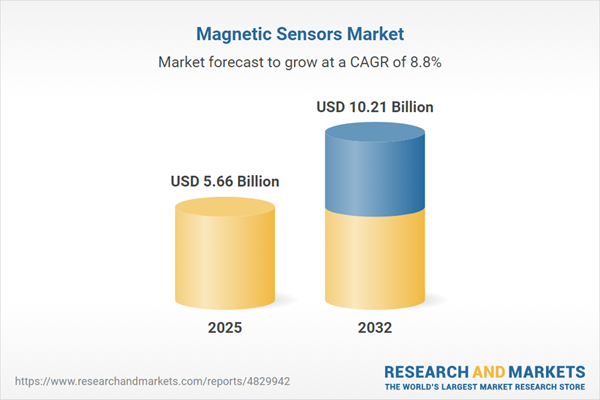Speak directly to the analyst to clarify any post sales queries you may have.
Magnetic sensors are driving advances in automation, connectivity, and sustainability as industries accelerate digital transformation. Senior leaders must consider both current applications and rapidly evolving supply chain, regulatory, and technology ecosystems to capture new market value efficiently.
Magnetic Sensors Market Snapshot
The Magnetic Sensors Market grew from USD 5.21 billion in 2024 to USD 5.66 billion in 2025. Continued growth is forecast at a CAGR of 8.76%, with the market expected to reach USD 10.21 billion by 2032. This expansion underscores the sector’s strategic importance as industries such as automotive, energy, healthcare, and industrial automation require improved precision, reliability, and connectivity. Demand for integrated sensing solutions is intensifying, with the rise of the Internet of Things and automation across manufacturing and commercial environments.
Scope & Segmentation
This report delivers a detailed examination of the magnetic sensors market, structured by technology, output type, application, packaging, channels, and regions:
- Sensor Types: Eddy current sensors, fluxgate sensors, Hall effect sensors, inductive sensors, and magnetoresistive sensors (including anisotropic, giant, and tunnel variations).
- Output Modes: Analog and digital sensors, addressing diverse integration needs.
- Packaging Types: Surface-mount (SMD) and through-hole modules, supporting high-volume production and easy prototyping.
- Applications: Aerospace and defense, automotive, consumer electronics, energy systems, healthcare, industrial automation, and IT & telecommunication.
- Sales Channels: Direct engagement and distribution network models.
- Supply Modes: Aftermarket support services and original equipment manufacturer (OEM) integration strategies.
- Geographic Coverage: Americas (including North America and Latin America), Europe, Middle East & Africa (covering distinct national and regional markets), and Asia-Pacific (including major and emerging economies).
Industry participants analyzed include 20 leading global companies, ensuring comprehensive competitive insights.
Key Takeaways for Senior Decision-Makers
- Magnetic sensor adoption is increasing with advancements in material science and device miniaturization, enabling performance suited for compact, power-sensitive, and high-precision applications.
- Automotive and energy sectors require advanced sensors for electric vehicles, grid monitoring, and safety-critical systems, emphasizing long-term platform compatibility and regulatory compliance.
- Collaboration is rising between sensor manufacturers and system integrators, allowing rapid prototyping and tailored solutions for emerging needs in robotics and Industry 4.0 environments.
- Supply chain resilience is strengthened through nearshoring, diversified supplier networks, and local manufacturing investments, directly responding to trade policy changes and logistical risks.
- Comprehensive customer support and segment-specific customization are fostering long-term relationships in high-margin niches such as medical instrumentation and advanced industrial controls.
Tariff Impact on the Magnetic Sensors Market
New tariffs introduced by the United States in 2025 have influenced global supply chains by raising input costs for specialized alloys and semiconductor components. Organizations are revising sourcing strategies, exploring domestic and allied suppliers, and adopting conservative inventory practices. Manufacturers are increasingly investing in local capacities and nearshoring to mitigate the impact of rising duties and ensure business continuity. These actions help stabilize pricing and delivery schedules, despite ongoing geopolitical uncertainties within the magnetic sensors market.
Magnetic Sensors Market Methodology & Data Sources
This analysis applies a multi-tiered approach using both secondary and primary research. The methodology covers a thorough review of industry publications, technical and regulatory documents, and direct engagement with senior industry executives. Rigorous data triangulation, expert panel input, and internal peer review ensure comprehensive and reliable insights for all segments of the magnetic sensors market.
Why This Report Matters for Industry Leaders
- Delivers actionable intelligence to guide strategic investments in technology, supply chain planning, and regulatory alignment for the magnetic sensors sector.
- Enables leaders to anticipate and capitalize on opportunities arising from regional market variations, technological integration, and evolving application landscapes.
- Supports more effective risk management by illuminating the impact of tariffs, material sourcing options, and operational agility in a global marketplace.
Conclusion
Magnetic sensors continue to shape innovation across critical industries. With sector-specific insights and forward-looking guidance, this report equips decision-makers to drive sustainable growth and operational excellence in a complex, evolving market landscape.
Additional Product Information:
- Purchase of this report includes 1 year online access with quarterly updates.
- This report can be updated on request. Please contact our Customer Experience team using the Ask a Question widget on our website.
Table of Contents
3. Executive Summary
4. Market Overview
7. Cumulative Impact of Artificial Intelligence 2025
Companies Mentioned
The companies profiled in this Magnetic Sensors market report include:- Allegro MicroSystems, Inc.
- Analog Devices, Inc.
- Asahi Kasei Microdevices Corporation
- Baumer Holding AG
- Elmos Semiconductor SE
- Honeywell International Inc.
- iC-Haus GmbH
- Infineon Technologies AG
- MultiDimension Technology Co.,Ltd.
- Murata Manufacturing Co., Ltd.
- NVE Corporation
- NXP Semiconductors N.V.
- Omron Corporation
- RLS d.o.o.
- Robert Bosch GmbH
- Sensitec GmbH
- STMicroelectronics N.V.
- TDK Corporation
- TE Connectivity Ltd.
- Texas Instruments Incorporated
Table Information
| Report Attribute | Details |
|---|---|
| No. of Pages | 185 |
| Published | November 2025 |
| Forecast Period | 2025 - 2032 |
| Estimated Market Value ( USD | $ 5.66 Billion |
| Forecasted Market Value ( USD | $ 10.21 Billion |
| Compound Annual Growth Rate | 8.7% |
| Regions Covered | Global |
| No. of Companies Mentioned | 21 |









